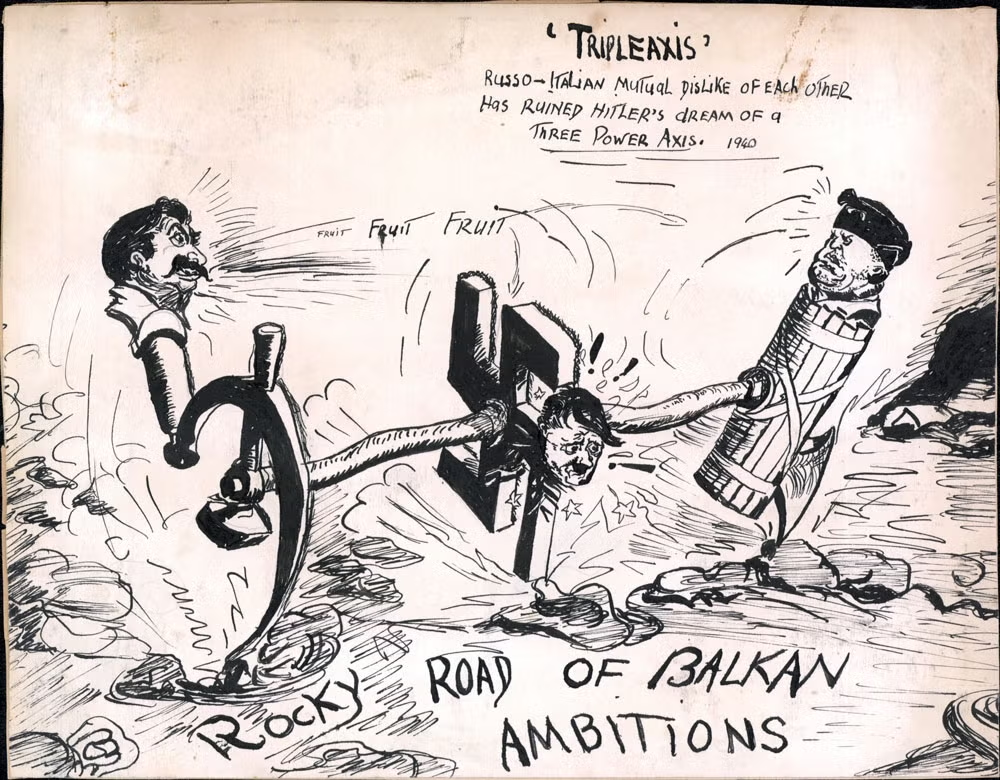
“Bad Choices” (October 31, 1940)
by Tom Smitch (unknown dates)
5.5 x 7 in., ink on board
Coppola Collection
Tom Smitch was an illustrator and cartoonist who worked as a printer in Ryde, for the Isle of Wight County Press. The Isle of Wight is the largest and second-most populated island of England. It is located in the English Channel, just south of Portsmouth. He was British Paratrooper whose work during WW2 is preserved in a book published in 1945, Engelsk krigshumor (English War Humor) with a Danish imprint (Kobenhavn, Samlerens forlag, 1945). He continued his artistic work with cartoons that appeared in the County Press. In an interview, he said about his wartime work, “Despite the heat, dust and flies, I have managed to accumulate a number of sketches. Art must go on if life may be short.” He provided illustrations for two books, at least: “West Indies Tour of England,” (1950), and “Newport Isle of Wight in Bygone Days,” (1952). And that is it for information.
In the cartoon, the Fuhrer is unhappy with the plays being made by Hermann Goering who was, among other things, head of the Luftwaffe. Late October 1940 marked the end of the Battle of Britain (July-Oct, 1940), and the first major defeat of Germany’s military forces, whose reputed air superiority had been seen as the key to sure victory.
The relationship between Hitler and Goering, a WW1 flying ace, was deeply rooted. When Hitler first attempted to seize power in the 1923 Beer Hall Putsch, Goering was by his side. Unlike Hitler, who went to prison, Goering escaped capture and fled to Austria, taking a bullet to his leg in the process. It was during this time that Goering first came in contact with morphine, to which he became addicted. After two rounds of institutionalization for psychiatric issues, probably resulting from the morphine use, he returned to Germany in 1927. Thanks to his loyalty to Hitler, he quickly rose to the Nazi Party’s upper ranks. His political efforts were instrumental to the Party winning the most seats during the 1932 election, and Goering managed to take the presidency of the Reichstag, which in turn resulted in giving Hitler the title of Chancellor, the de-facto leader of Germany. Among other strong political positions, Hitler appointed Goering as the Commander-in-Chief of the Luftwaffe. From his position of power, one of his first key acts was to create the Gestapo. By the outbreak of World War II in 1939, Hitler had named Goering as his successor.
Goering’s rise through the ranks of the Nazi party was accompanied by his ever-expanding waistline (note the delightful dig at this in the cartoon, with a frame picture of a sausage on the wall). His ongoing morphine addiction made him prone to have severe mood swings and may have contributed to the weight gain that transformed the former dashing war hero into the portly figure that was an easy target for mockery. His indulgence went beyond food and drugs. He lived lavishly, setting himself up in a palace in Berlin he named for his first wife. His natural flair for flamboyance and pomp led to him to change uniforms at least five times a day, occasionally donning a medieval hunting uniform or even, as one visitor reported, a full toga and sandals.
Goering’s celebrity came to an abrupt halt in 1940. As head of the Luftwaffe, Goering was responsible for the great air offensive against the one enemy that still stood against Germany in Europe: Britain. However, when the Royal Air Force managed to beat back the Germans against all odds, during the Battle of Britain, Goering bore the brunt of the blame.
Historians tend to agree that disorganization and competing priorities led to two big blunders that, otherwise, might have had this battle go badly for the British. Churchill gave an inspired speech on June 18 announcing ‘the Battle of France is over and the Battle of Britain is about to begin.’ The Germans waited 3 weeks before making a move, which gave a lot of time for the RAF to prepare. Also, against all rules of warfare, the Luftwaffe ended up going after civilian targets, including racking up the political capital of bombing London, rather than focusing on wiping out the airfields and other military installations. Hitler’s attention was on the upcoming surprise attack on Russia. Yet, still, the Luftwaffe fell immediately into a period of intensive blame-laying, including questioning the choices made by Goering.
In the ensuing years, although Goering retained a great deal of authority throughout the war, he increasingly fell from the Fuhrer’s favor and he became more heavily addicted to drugs.
On April 23, 1945, when Hitler was cut off in Berlin as Soviet troops encircled the capital, Goering (who had once again escaped from Germany) sent a telegram to Hitler requesting authorization to take over as Hitler’s successor. Hitler denounces Goering as a traitor, strips him of all his offices, and orders his arrest.
A week later, the defeated Hitler committed suicide. Goering was found and arrested, and was perhaps the highest-ranking member of the group brought to trial at Nuremburg. The day before his scheduled execution, while in custody, he managed to commit suicide with a cyanide pellet.










 “So Am I” (October 8, 1940)
“So Am I” (October 8, 1940)


